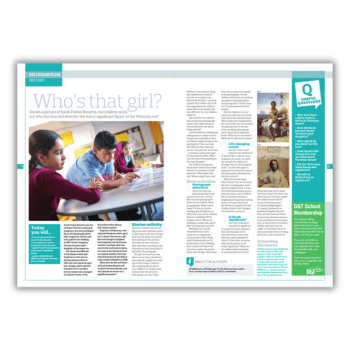Can children work out who Sarah Forbes Bonetta was and whether she was a ‘significant figure’ of the Victorian era?
Learning objectives
- Find out about the life of Sarah Forbes Bonetta
- Use evidence to reach a conclusion about the past
- Decide if Sarah Forbes Bonetta was/is a significant person
- Explore similarities and differences between Victorian times and today
Who was Sarah Forbes Bonetta?
Sarah Forbes Bonetta was one of Queen Victoria’s many goddaughters. She led a privileged life as the Queen paid all her bills, bought her clothes, and even paid for her wedding in 1862.
Sarah’s daughter, Victoria, became a goddaughter of the queen too. But Sarah was different to the Queen’s other goddaughters as she was an African princess.
Born in 1843, she was captured, aged four, during a slave raid and intended to be a sacrifice, but her release was arranged by Captain Forbes, of the Royal Navy West African anti–slavery patrol.
King Gezo of Dahomey, who captured Sarah as a slave, gave her to Queen Victoria as a gift. She was brought to England and frequently met the Queen, until her marriage when she went to live and work in Africa.
For most of her life Sarah lived as a typical wealthy Victorian, until she became ill and died of tuberculosis in Madeira in 1880.
Starter activity
Show the children this picture but don’t tell them who it is. Ask them to list three things they can tell about the person from looking at the portrait, then discuss their answers.
Now ask them to produce a list of questions they would like to ask about the young girl. The girl in the picture was about seven years old when it was painted, roughly the same age as Key Stage 1 children.
Use a photograph of one of your children to compare and contrast the two pictures. How similar are they? How different? One obvious thing the children may notice is that the two subjects are differently dressed – can they explain why?
Make a list of all the suggestions the children make about how similar and how different the two children might be.
Ask whether the children like having their photograph taken. How might the girl in the portrait have felt about being painted?
Extend children’s thinking by asking them to collate a list of things they would like to find out. Where might the girl in the painting live? How can they tell? Why do they think the picture was painted? And when – recently or a long time ago? (It was painted in 1851.) Why?
Can they place the painting on the class timeline? The children should also think about where they might find out the answers to their questions. Who might they ask? Where might they look?
Alf Wilkinson is CPD Manager for the Historical Association. He is a former head of history and ICT coordinator. Browse more Black History Month activities.














